
| Home | Contact Us | Site Map | Search |
 |
||||
|
|
|
|
|
Networking was a major theme of the two-day forum, which also featured a panel on loan repayment and research funding opportunities, and career advice from clinician-scientists who recently completed their residency and sub-specialty training, as well as a keynote speech from dean of the Duke University School of Medicine, Dr. Nancy Andrews. New this year, organizers used the technology of micro-blogging site Twitter to connect with the audience and encourage conversation. Invited were medical, dental, and veterinary students participating in year-long research programs: Howard Hughes Medical Institute (HHMI)-NIH research scholars and HHMI medical fellows, Doris Duke Charitable Foundation (DDCF) clinical research fellows, National Center for Research Resources/Clinical and Translational Science Award-sponsored students in year-long research programs, NIH Clinical Research Training Program (CRTP) fellows, Sarnoff Cardiovascular Research Foundation fellows, fellows in the applied epidemiology fellowship at the Centers for Disease Control and Prevention, Fogarty International clinical research scholars, and the NIH MD/PhD Partnership Training Program fellows. “I was excited to do a year of research—to get a chance to be curious, which you don’t get much time for in medical school,” said attendee Stephen Schleicher from Vanderbilt University School of Medicine of his decision to enter the HHMI medical fellows program. CC Director Dr. John I. Gallin, National Institute of Mental Health Director Dr. Thomas R. Insel, National Institute of Arthritis and Musculoskeletal and Skin Diseases Director Dr. Stephen Katz, and National Center for Complementary and Alternative Medicine Director Dr. Josephine P. Briggs kicked off the presentations with highlights of recent research from their respective institutes and centers and opportunities for the students gathered in Masur Auditorium. Briggs encouraged them to “listen to some quirky ideas outside the mainstream,” citing Lamaze and Pilates, prevalent therapies today that were once dismissed as nonscientific. Some CIST Forum attendees already have decided what to go into and came with an agenda. “I’m here to meet my future colleagues and try to meet some of the other NIH faculty like Les Biesecker. My PI was a resident with him and knew that he would be a good match for me as a career mentor,” said Bimal Chaudhari, another DDCF fellow and a Boston University School of Medicine student interested in genetic epidemiology.
“My favorite was the luncheon because I got to meet some of the leaders in the field,” said Xiaolong (Alan) Zhou, a Duke University School of Medicine CRTP fellow. “For me, in dermatology, I got to meet Dr. Stephen Katz and a couple of the other dermatologists in the branch and talk about the field as it is right now and what we as medical students should be looking forward to.” Day one wrapped up with Dr. Andrews’ keynote speech following a networking dinner. Myers was joined by speakers from the NIH Office of Extramural Research and the Columbia University College of Physicians & Surgeons to speak on day two about grants and educational debt, prominent areas of interest among young researchers. Dr. Jaime S. Rubin from Columbia showed a photo from before the electronic age of an NIH mail room packed from floor to ceiling with FedEx boxes holding grant applications. Her parting words: “Good luck.” Tools of the trade, such as NLM’s PubMed and the CC’s Biomedical Translational Research Information System, rounded out the forum’s panel offerings. Speakers were asked questions from techies in the audience identified only by their Twitter handles on the micro-blogging site, and CIST Forum organizers responded with follow-up links posted on their accounts: NIHClinicalCntr and CCMedEd. “It was really our attempt to not only be contemporary in our ability to use these social networking tools but also to readily provide information to the students based on the questions they asked,” Ognibene said. Follow NIHClinicalCntr at http://twitter.com/NIHClinicalCntr to learn more about the CIST Forum. Duke medical school dean gives CIST keynote
Dr. Nancy Andrews, dean of the Duke University School of Medicine, was the keynote speaker at the Clinical Investigator Student Trainee (CIST) Forum, a gathering of future clinician-scientists in year-long research fellowships. Andrews, the first and only female dean of a top-ten medical school, spoke on her research background, her perspectives on health-care, and her experiences as a woman in science. She received her bachelor’s degree in molecular biophysics and her master of science in biochemistry from Yale University, her doctorate in biology from Massachusetts Institute of Technology, and her medical degree from Harvard Medical School. Andrews completed her internship and residency in pediatrics at Children’s Hospital Boston, and her hematology/oncology fellowship at Children’s Hospital and the Dana-Farber Cancer Institute. She was a full professor of pediatrics and dean for basic sciences and graduate studies at Harvard Medical School before she was appointed vice chancellor for academic affairs and dean of the Duke University School of Medicine in 2007. “I remember my high school biology teacher telling us it would never be possible to sequence DNA,” she began, before telling the CIST Forum attendees that in their careers they would likely see genomic sequencing as a routinely analyzed part of a patient’s medical record. “The lesson in that is that you should never say never in science and that you should be very ambitious in your goals,” Andrews said. “Because unless you aim high, you have no chance of getting there.”
Andrews used patient case studies to illustrate the value of investigative instincts and collaboration with peers who offer complementing specialties. She recommended attention to access of health-care delivery. “We also need to be thinking of course about preventing disease in the first place and changing medicine so that it becomes more proactive and less reactive—working toward preserving health rather than treating disease.” Questions from female trainees in the audience asked for advice on overcoming bias and on balancing a successful career with a strong home life. “Until we make careers and academic positions and places in medical school classes truly accessible to everybody we’re losing out on a lot of talent,” Andrews responded to the first. Her answer to the inquiry on how to have it all embraced its possibility. “There are myths out there about how hard it is to have a family and a career, and I just don’t think that that’s really true anymore,” she said. “Most of the time it’s probably more manageable than young women are told.” CIST program alumni panel advises
|
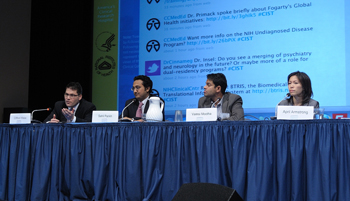 |
|
Alumni from four of the research fellowship programs represented at the CIST Forum—(from left) Dr. Clifford Weiss, Dr. Sahil Parikh, Dr. Vamsi Mootha, and Dr. April Armstrong—comprised a panel offering advice to their successors. Students could ask questions of the speakers, and see follow-up from forum organizers, through the micro-blogging Web site Twitter (seen in the background).
|
CIST Forum students got a confidence boost from Dr. Clifford Weiss, assistant professor of radiology at Johns Hopkins University School of Medicine, who told the trainees not to call their current research fellowships a year off. “It’s a year of good, hard work you’re doing in another arena,” he said.
Dr. Vamsi Mootha, associate professor in the Department of Systems Biology and Medicine at Harvard Medical School, called his time as an HHMI scholar a life-changing year, and asked his audience to acknowledge the spectrum of clinical science and to think where on that continuum they’d like to fall.
Wherever they land, the trainees are already a step ahead and should remember as much when moving on to the next phase of their careers, said Weiss. “Sell yourselves for who you are—research scientists. That’s a very powerful thing to be, and it will take you far,” he said.
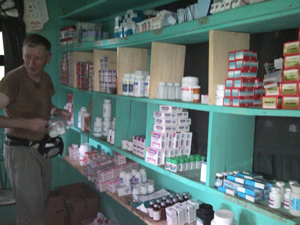 |
| CC pharmacist Frank Nice works in the Carcasse, Haiti, pharmacy—one wall of general analgesics and antibiotics to treat the many ailments of the town’s couple thousand residents and the thousands more who live in the surrounding mountains. |
Nice, a Clinical Center pharmacist, has made the 18-hour trip once a year, first with the St. Frances of Assisi church in Derwood, Md., then with a non-profit the same medical mission group started—Health and Education for Haiti. He traveled to Central America with CC pharmacist Fortin Georges and CC pharmacy technician Sila Claure and a former (now FDA) CC pharmacist.
“That’s the real practice of medicine, down there,” Nice said. “And whatever we do in Haiti, we come back with much more.”
Nice’s efforts began in Leon, Haiti, but that clinic has become mostly self-sufficient, so his group opened another on the western tip of the country, an area bereft with poverty and inaccessible, if any, medical care. He told the story of a boy in Carcasse who fell into a fire and had to endure a five-hour motorcycle ride to seek treatment for his severe facial burns.
Prevalent in that part of the world are infectious diseases, but also chronic disorders such as hypertension. Each member of the Health Education for Haiti team checked on the plane two 50-pound bags—the limit—full of donated medical supplies and pharmaceuticals.
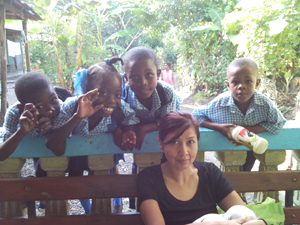 |
| The children of the Haitian village like to play with and perform for he visiting volunteers. Above, four in their school uniforms mug for the camera with CC pharmacy technician, Sila Claure. |
Credentialed by the Haitian Department of Health, the medical team—who pay for their own travel—operates just as they would in the United States—doctors and nurse practitioners diagnose and the pharmacists dispense the necessary medications.
The visiting health care providers attracted patients from the surrounding mountainous region, some who walked for 24 hours for a chance to be seen, Nice said. “I’m not talking macho men, either—little old grandmothers and people carrying other people.”
Another goal of the group is to travel into the segmented communities outside Carcasse to bring care to those who cannot travel. For now, Nice will go to Thomassique, Haiti, on a trip with Rutgers pharmacy students in January and back to Carcasse next October. He must continue his work in the dispensaire and see his godchildren, the daughters of friends he made on one of his first medical missions.
“It’s intangible, all that they give us,” Nice said.
The educational courses offered annually by the Clinical Center have record enrollments for the 2009-2010 term.
Introduction to Principles and Practice of Clinical Research covers the basics of how to conduct clinical research. This year, 1,296 students are enrolled—462 on-site (classes are held in Lipsett Amphitheater) and another 834 students participating through video links to 26 sites around the world. The course has had nearly 9,000 enrollees since its inception in 1995. Topics include an introduction to clinical research and its history; clinical research from a patient’s perspective; data analysis techniques; ethical and regulatory issues; and how to plan, design, and fund clinical research studies.
Principles of Clinical Pharmacology has 813 students this year—385 at NIH and 428 participating through videocast to 21 other locations. The course is designed for researchers interested in the clinical pharmacologic aspects of drug development and use. More than 5,000 students have enrolled since the course was first offered in 1998.
Ethical and Regulatory Aspects of Clinical Research covers a broad range of issues central to the ethical conduct of clinical research. This year, 293 students are participating at the CC and through videocast to six locations. Nearly 4,000 students have taken this course since it began in 1999.
“This program, made of three courses, was initiated to help improve how clinical research, research involving patient-volunteers, is carried out. The training is comprehensive and easy to access,” said CC Director Dr. John I. Gallin. “Our goal is to help prepare the next generation of clinical researchers and ensure that current clinical research is safe, efficient, and ethical.”
“Clinical research is a multidisciplinary enterprise, and these courses attract the full range of health professionals,” said Dr. Frederick P. Ognibene, CC deputy director for educational affairs and strategic partnerships and director of the Office of Clinical Research Training and Medical Education.
Learn more at http://clinicalcenter.nih.gov/training.
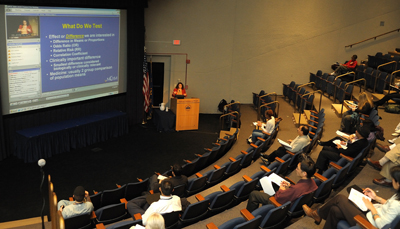 |
| Dr. Laura Lee Johnson, statistician in the NCCAM Office of Clinical and Regulatory Affairs, traveled to China with the IPPCR course last year. She teaches to students in Lipsett Amphitheater and watching remotely via videocast. The list on the bottom left of the screen shows the participating locations from around the world. |
Dr. Ann Berger, chief of Clinical Center Pain and Palliative Care, was among an international group of speakers at a Middle East Cancer Consortium (MECC) November workshop in Israel attended by Israeli and Palestinian caregivers: physicians, nurses, social workers, pharmacists, and volunteers. The Palestinians came from the West Bank, and half of the Israeli group was Arabs.
The MECC is a network of the ministries of health of Cyprus, Egypt, Israel, Jordan, the Palestinian Authority, and Turkey. Its objective is to reduce the incidence and impact of cancer in the Middle East through the solicitation and support of collaborative research.
The workshop Berger spoke at focused on the assessment and management of pain along with management of other symptoms such as dyspnea, nausea and vomiting, fatigue, and delirium. Cultural aspects as related to palliative care were discussed at length—the use of opioids and ways to overcome some of the traditional barriers associated with the use of opioids in the Middle East. Potential solutions have been proposed that included the involvement of health-care providers and health-care administrators.
Other presenters included Dr. Stefan Friedrichsdorf from the Minnesota Children’s Hospitals and Clinics; Dr. Simon Wein from the Davidoff Cancer Center, Beilinson Medical Center, Israel; and Nathan Cherny of the Shaare Zedek Medical Center, Jerusalem, Israel.
The workshop took place at the Shaare Zedek Medical Center, which cares for both Israeli and Palestinian patients, and the group also visited the Yad Sarah National Center in Jerusalem, Israel’s unique volunteer network of homecare support services.
On November 6 the Israel state-run television station reported (in Hebrew, Arabic, and English) this event as a symbol of goodwill toward Israeli-Palestinian collaboration in the treatment of cancer patients.
New approaches for sharing information about recreation therapy activities are being piloted in two locations this month. It’s a project conceived by the Recreation Therapy Section in the Clinical Center’s Rehabilitation Medicine Department. The pilot tests the use of calendars that are easier to read and update.
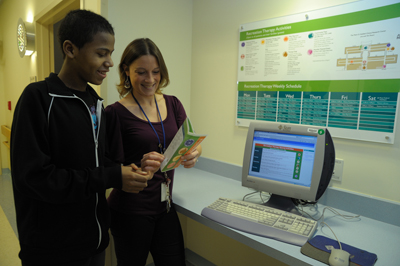 |
| Recreation therapist Laura Maring reviews the new Recreation Therapy Section schedule board with Yonjari Figuereo of the Dominican Republic. The permanent board of program descriptions’ content is available on a flyer in Spanish and on the patient portal Web site. |
The schedule of events is also audiocast each month on CC Radio, accessible through the CC Web site, and posted on the patient portal.
In this pilot stage, the new schedule boards sit on 1NW, 5NW, and in the CC patient library. Recreation Therapy is educating staff and patients and their families on the new look and feel of the information delivery system. In the meantime, the current paper calendar system will continue on other patient units. The department is also collecting feedback from users through focus groups and unit-based nursing input. This information will help tweak the product before its eventual roll-out to all other patient units.
“A lot of collaborative energy has gone into this patient-centered initiative,” said Recreation Therapy Section chief Donna Gregory. “We have received positive feedback from patients and families in the first few weeks of piloting the project. The most frequent response from patients so far is, ‘it is so much easier to read.’ Several families have commented on the value of having the new activity schedule format in Spanish and on the patient portal Web site.”
The Astute Clinician Lecture series honors a US scientist who has observed an unusual occurrence, and by investigating it, has opened an important avenue of research. “You will never understand a system as well as when you have an opportunity to observe when something goes wrong,” said NIH Director Francis Collins in his introduction of this year’s honored scientist, his friend Dr. Daniel Kastner, chief of the National Institute of Arthritis and Musculoskeletal and Skin Diseases Genetics and Genomics Branch, as well as the institute’s clinical director and director of translational research in the intramural research program. Kastner also serves as deputy director of NIH Intramural Clinical Research.
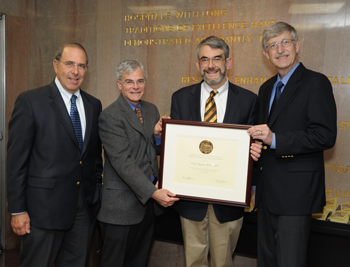 |
| From left, CC Director Dr. John I. Gallin, NIH Deputy Director for Intramural Research Dr. Michael Gottesman, and NIH Director Dr. Francis Collins presented Dr. Daniel Kastner (second from right) with a certificate noting his Astute Clinician Lecture. Kastner spoke about his discovery of the cause of TRAPS, a dominantly inherited periodic fever syndrome. |
Kastner led an international consortium that identified the gene causing familial Mediterranean fever in 1997, and his group subsequently discovered that mutations in the p55 tumor necrosis factor receptor cause a dominantly inherited periodic fever syndrome that they named TRAPS (the TNF receptor-associated periodic syndrome). Based on these findings, Kastner proposed the term “autoinflammatory” to describe the family of diseases characterized by seemingly unprovoked episodes of inflammation, without high-tier autoantibodies or antigen-specific T-cells, which are now known to be disorders of the immuine system.
With NIAMS collaborators, his team has gone on to identify the genetic basis of other Mendelian autoinflammatory diseases, and they follow a large cohort of these patients at the Clinical Center.
The Astute Clinician Lecture Series is made possible by a donation from the late Dr. Robert W. Miller and his wife, Haruko.
The NIH Dietetic Internship program, under the Clinical Center Nutrition Department, welcomed 53 dietetic interns and five dietitians from nine area dietetic internships for a class day on public policy and integrative nutrition on November 16.
The morning session, a presentation from Tracy Fox, registered dietitian and president of Food, Nutrition & Policy Consultants, LLC in Washington, DC, was coordinated by the Virginia Tech Dietetic Internship program. In “Public Policy and Dietetics: Passion into Action,” Fox defined grassroots advocacy and listed its key components and rules for efficacy.
The afternoon session on integrative nutrition was coordinated by the NIH Dietetic Internship. Merel Kozlosky, director of the NIH Dietetic Internship, describes integrative nutrition as the integration of traditional nutrition therapies with evidence-based complementary and alternative practices. “As integrative medicine becomes more prominent in the health-care process, it is important for dietetic interns to be able to incorporate evidence-based integrative nutrition into their practices,” she said.
Dr. Ranganath Muniyappa, a staff clinician in the Diabetes Unit of the National Center for Complementary and Alternative Medicine, presented “Functional Foods and Dietary Supplements in Metabolic and Cardiovascular Health: Is it Tea Time Yet?” A nutritionist for the NIH Office of Dietary Supplements, Jody Engel taught participants how to evaluate if a product is manufactured safely and informed the dietetic interns about the Office of Dietary Supplement’s many health professional and consumer resources in “Dietary Supplements: What Registered Dietitians Need To Know.”
The day wrapped with Annie Kay, a registered dietitian working for a nutritional supplement manufacturer and a health and medical writer. Her “Integrative Nutrition: Real World Applications” talk touched on how and why yoga, mindfulness, and Eastern-based philosophies integrate with nutrition practice for weight management.
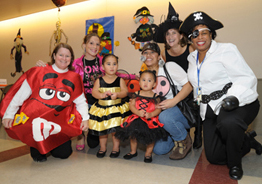 |
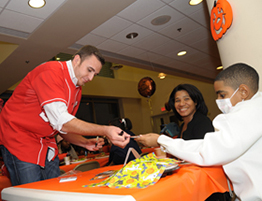 |
Patients and their families came in costume for some treats and tricks—mummy-making and costume contests.
Anaiah and Ariana Tagoloa—children of a CC patient—won for sweetest bee and luckiest ladybug.
They partied with mom Reva and Recreation Therapy staff (from left) Kristin Johnsen, Laura Maring, Holly Cobb Parker, and Dr. Renee Stubbs.
Two special guests weren’t playing dress-up—the jerseys on Nationals baseball players Craig Stammen and John Lannan (below, right) were real. The pitchers signed baseball cards and visited with the party guests—including patient Cristopher Peralta Portes.
Setting limits in the holiday season: parenting seminar
“Presence for the Holidays” is the theme of the December parenting seminar sponsored by the NIH Child Care Board and the Office of Research Services Division of Amenities and Transportation Services. This free informative discussion from Jennifer Alfonso of LifeWork Strategies will take place December 8, from 2 to 3 pm in Building 31/Room 6C10.
“Presence for the Holidays” will focus on the value of spending time with your children and the impact of overindulgence. Alfonso will define the “freedom of limits” and present how parents and grandparents can create meaning for children and their families during the holiday season outside the frenzy of gift-giving. Share your experiences with other parents and learn strategies for recognizing and reducing family stress.
The seminars will be videocast at http://videocast.nih.gov. Learn more at http://does.ors.od.nih.gov/childcare/parent_seminars.htm.
And a Wii we go
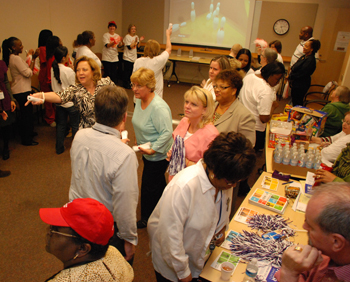 Nursing and Patient Care Services (NPCS) held a Wii bowling event in mid-November to publicize the Combined Federal Campaign. Keyworkers talked about the different charities and how to donate while members of the Clinical Center’s largest department swung their controllers to strikes and spares.
Nursing and Patient Care Services (NPCS) held a Wii bowling event in mid-November to publicize the Combined Federal Campaign. Keyworkers talked about the different charities and how to donate while members of the Clinical Center’s largest department swung their controllers to strikes and spares.
Josanne Revoir of NPCS noted a strong presence from the inpatient and ambulatory care nursing services. “Despite the news reports on the global spread of Wii’s, some coaching was necessary for a number of first-timers,” Revoir said.
The CFC continues through January.
NCCAM symposium celebrates tenth year
The National Center for Complementary and Alternative Medicine (NCCAM) will celebrate a decade of rigorous research with NCCAM’s 10th Anniversary Research Symposium: Exploring the Science of Complementary and Alternative Medicine in Masur Auditorium on December 8.
Speakers will discuss topics including natural products, mind-body medicine, and the intersection of behavioral science and integrative medicine. The keynote—“Stress, Coping, and Well-Being: Behavioral Science Meets Integrative Medicine”—will be delivered by Dr. Susan Folkman from the University of California, San Francisco.
Also presenting at the symposium will be Dr. Jeffrey Gordon, Washington University School of Medicine in St. Louis; Dr. Claire Fraser-Liggett, University of Maryland School of Medicine; Dr. Joseph Noel, The Salk Institute for Biological Studies; Dr. Bruce Rosen, Harvard Medical School; and Dr. Richard Davidson, University of Wisconsin-Madison.
The day kicks off at 9 am. Registration is not required. Visit http://nccam.nih.gov/ for more information. Join the meeting on Twitter by searching for and tagging Tweets with #nccamten.
All will be videocast at http://videocast.nih.gov.
December 2, 2009
CC Grand Rounds
Lipsett Amphitheater, 12 noon
Ethics Rounds
Research on the Dying
Daniel P. Sulmasy, OFM, MD, PhD
Kilbride-Clinton Professor of Medicine and Ethics, Department of Medicine and the Divinity School
Associate Director, MacLean Center for Clinical Medical Ethics
University of Chicago
Wednesday Afternoon Lecture Series
Masur Auditorium, 3 pm
Shotgun siRNA Perturbation to Dissect Growth Factor Triggered Proliferation and Migration Signaling Systems
Tobias Meyer. PhD
Professor, Department of Chemical and Systems Biology, Stanford University School of Medicine
December 3, 2009
Wednesday Afternoon Lecture Series
Masur Auditorium, 3 pm
Special Thursday Lecture
Sorting It All Out: Signal-mediated Protein Trafficking in the Endosomal-Lysosomal System
Juan Bonifacino, PhD
Head, Cell Biology and Metabolism Program, Eunice Kennedy Shriver National Institute of Child Health and Human Development
NIH Distinguished Investigator
December 9, 2009
CC Grand Rounds
Lipsett Amphitheater, 12 noon
Contemporary Clinical Medicine: Great Teachers
Treatment of Parkinson’s Disease
Joseph Jankovic, MD
Professor of Neurology and Distinguished Chair in Movement Disorders
Director, Parkinson’s Disease Center and Movement Disorders Clinic, Department of Neurology
Baylor College of Medicine
Wednesday Afternoon Lecture Series
Masur Auditorium, 3 pm
The Novel Physiology of Bone
Gerard Karsenty, MD, PhD
Professor and Chairman, Department of Genetics and Development, Columbia University Medical Center
December 16, 2009
CC Grand Rounds
Lipsett Amphitheater, 12 noon
Ninth Annual John Doppman Memorial Lecture for Imaging Sciences
CTA and 3-D Visualization: Its Evolving Role in Oncologic Imaging
Elliot K. Fishman, MD
Professor of Radiology and Oncology, Johns Hopkins University School of Medicine
Director, Division of Diagnostic Imaging
Director, Division of Abdominal Imaging and Computed Body Tomography
The Johns Hopkins Hospital
Wednesday Afternoon Lecture Series
Masur Auditorium, 3 pm
From Cell Phones to Cell Biology: High Tech, Low Cost Solutions for Global Health
Rebecca Richards-Kortum, PhD
Stanley C. Moore Professor of Bioengineering, Rice University
This page last updated on 12/14/2017
 The information on this page is archived and provided for reference purposes only.
The information on this page is archived and provided for reference purposes only.
|
|